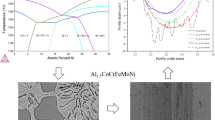Abstract
In the quest for the ideal transformation model describing the austenite decomposition in steel, emphasis shifts from empirical to physical models. This has resulted in the widely used description of the transformation by means of the interface velocity between the parent phase and the newly formed phase, a description which yields reliable predictions of the transformation behavior only when combined with a realistic austenite geometry. This article deals with a single-grain austenite geometry model applied to transformations in which the interface velocity is constant throughout the transformation, e.g., certain types of massive transformations. The selected geometry is a regular tetrakaidecahedron, combining topological features of a random Voronoi distribution with the advantages of single-grain calculations. The simulations show the influence of the ferrite-nucleus density, the relative positions of the ferrite nuclei inside the austenite grain, and the grain-size distribution. From simulations with a constant interface velocity, the transformation behavior for a tetrakaidecahedron is in agreement with transformation kinetics in terms of the Johnson-Mehl-Avrami (JMA) model. Using the tetrakaidecahedron geometry, one can simulate transformation curves that can be experimentally obtained by calorimetry or dilatometry, in order to study the quantities affecting the transformation behavior.
Similar content being viewed by others
References
R.W. Heckel and H.W. Paxton: Trans. TMS-AIME, 1960, vol. 218, pp. 799–806.
R.A. Vandermeer: Acta Metall. Mater., 1990, vol. 38, pp. 2461–70.
T. Gladman: The Physical Metallurgy of Microalloyed Steels, 1st. ed., Institute of Materials, London, 1997, pp. 144–48.
J.W. Johnson and R.F. Mehl: Trans. AIME, 1939, vol. 135, pp. 416–58.
M. Avrami: J. Chem. Phys., 1939, vol. 7, pp. 1103–12.
M. Avrami: J. Chem. Phys., 1940, vol. 8, pp. 212–24.
M. Avrami: J. Chem. Phys., 1941, vol. 9, pp. 177–84.
W. Huang and M. Hillert: Metall. Mater. Trans. A, 1996, vol. 27A, pp. 480–83.
C. Zurek, E. Sachova, and H.P. Hougardy: Abschlussbericht Project COSMOS, Max-Planck-Institut für Eisenforschung GmbH, Düsseldorf, 1993.
A. Thorvaldsen: Acta Mater., 1997, vol. 45, pp. 587–94.
M. Militzer, R. Pandi, and E.B. Hawbolt: Metall. Mater. Trans. A, 1996, vol 27A, pp. 1544–1553.
G.P. Krielaart, J. Sietsma, and S. van der Zwaag: Mater. Sci. Eng. A, 1997, vol. 237A, pp. 216–23.
G.P. Krielaart and S. van der Zwaag: Mater. Sci. Eng. A, 1998, vol. 246A, pp. 104–16.
R.C. Reed and H.K.D.H. Bhadeshia: Mater. Sci. Technol., 1992, vol. 8, pp. 421–35.
V.M.M. Silalahi, M. Onink, and S. van der Zwaag: Steel Res., 1995, vol. 66, pp. 482–89.
Author information
Authors and Affiliations
Rights and permissions
About this article
Cite this article
van Leeuwen, Y., Vooijs, S., Sietsma, J. et al. The effect of geometrical assumptions in modeling solid-state transformation kinetics. Metall Mater Trans A 29, 2925–2931 (1998). https://doi.org/10.1007/s11661-998-0199-6
Received:
Issue Date:
DOI: https://doi.org/10.1007/s11661-998-0199-6




